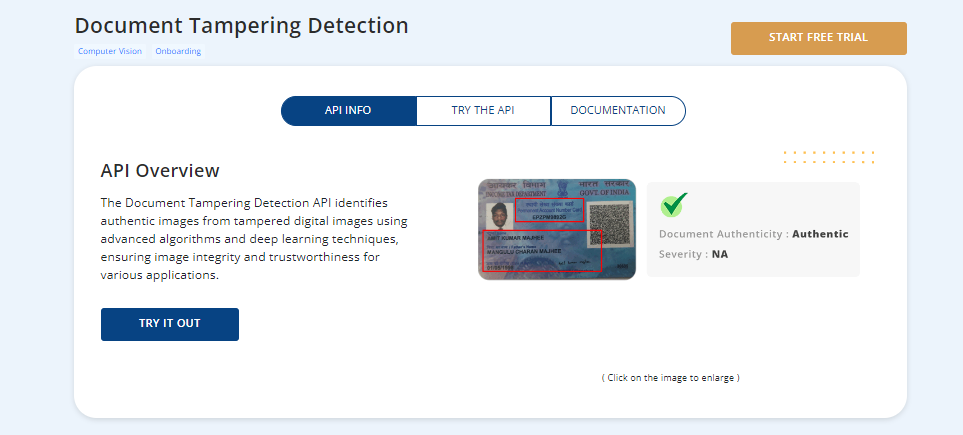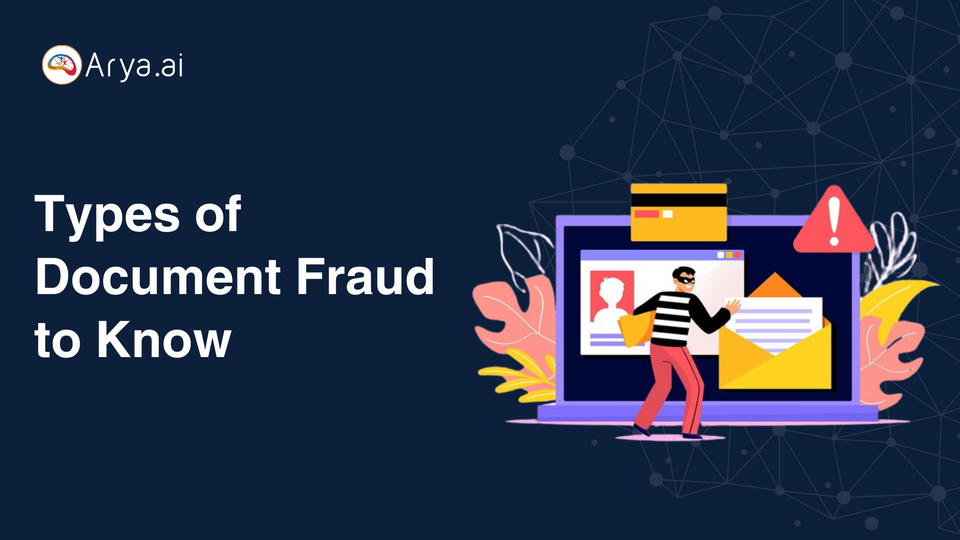Financial document fraud has increased in the last two years. Scammers are using their skills to forge documents and make money. From creating documents using basic graphic designing software to advanced methods like template hijacking, scammers manipulate documents to their advantage.
According to Europol, the European Union's law enforcement agency, document fraud is one of the three central pillars of organized crime prevalent today. Apart from using fraudulent documents to make money, criminals are using online marketplaces to trade these documents and generate hefty income.
In this post, we will share everything you need to know about document fraud - what it is, how it happens, its types, and how to detect it to stop it from happening.
What is Document Fraud?
Document fraud is creating and altering genuine documents or using false documentation to deceive organizations into obtaining loans, acquiring property, illegally entering a country, or any other benefit. Document fraud also happens when a scammer fraudulently obtains genuine documents and misuses them for their own benefit.
According to the annual fraud report released by the Federal Trade Commission, fraudulent activities caused losses of around $10 billion in 2023. The report also stated that 48% of these reports were about fraud, followed by identity theft at 19%.
1 in 5 people have reported a financial loss due to scamming by imposters. Here is how document fraud can occur in various industries.
- Banking - Fraud can take place in banking services where scammers try to gain access to funds by producing fake documents for loan applications, credit card applications, bank statements, and more. This could lead to heavy financial losses and compromise your customers’ trust in your bank.
- Finance and Legal - The finance and legal companies are prone to billing fraud where scammers produce fraudulent invoices and financial statements to gain an advantage. There have been instances where scammers have altered signatures, forged contracts, and created counterfeit court documents to deceive businesses.
- Retail - The retail industry may face document fraud via counterfeit receipts, altered bills, or fraudulent checks. Fraudsters may use these counterfeit receipts to falsely claim warranty for goods or return them. They might also use tampered checks that are illegitimately obtained as payment for the goods. This can cause unexpected changes in inventory and may also damage the brand's reputation.
- Insurance - Scammers use fake documents to make false insurance claims leading to financial losses for the company. This may cause you to increase the premium rates of insurance plans for other customers.
- Real Estate - The real estate industry is most prone to document scams. The identity of property owners is forged to sell or mortgage properties without the real owner's consent. Scammers also alter sales deeds, titles, and other important property documents to deceive customers.
That being said, let us explore the different types of document fraud you are likely to encounter.
Types of Document Fraud
Scammers do documentation fraud to steal someone's identity or to create a fake identity to carve their way into application approval. For instance, creating a fake identity document like a passport to enter a country.
Let us focus on some of the most common types of document fraud-
#1. Document Forgery
Document forgery is the process of making fake documents or imitating real ones to make new documents entirely from scratch. Fraudsters can completely change information in these documents or partially alter it thereby affecting its integrity. This includes counterfeiting a wide range of documents like passports, identification cards, driving licenses, financial records, contracts, and many others. Up until recently, there have been many occurrences of digital document forgery where scammers are creating convincing replicas of electronic documents for their fraudulent activities.
The motto behind document forgery can be identity theft, financial fraud, or immigration.
#2. Document Alteration
As the name suggests, document alteration is the process of manipulating the details of genuine documents, both physical and digital with the intention of deceiving others. It can be as simple as changing the name, address, phone number, or any other information. Document alteration is sometimes referred to as document manipulation as there are subtle changes done to the documents. These falsified details are likely overlooked by the organizations and assumed to be true.
Fraudsters engage in document alteration for a variety of reasons including fraud, identity theft, legal manipulation, and academic fraud.
#3. Document Image Fraud
Image fraud is a type of document fraud that involves manipulating or altering images in a document to convey false information. It includes editing images to add or remove certain elements, adding textures, altering image colors, or simply superimposing multiple images to build an entirely new image.
Image fraud is sometimes also referred to as photo fraud. Fraudsters leverage various image editing software and deep fake engineering techniques to manipulate digital images to fabricate identities and create misleading impressions of the original document.
#4. Synthetic Identity Fraud
Synthetic identity fraud is a type of identity theft where fraudsters create a completely new identity by using a mix of real and falsified information. It is like creating a fictitious person by stealing some real information and combining it with some fake information. As synthetic identity fraud involves creating new identities, it does not raise immediate suspicion.
Fraudsters usually steal information like social security numbers and addresses and pair it up with fictional names to create these new identities for securing credit cards and loans. They build excellent credit profiles for these identities before exploiting the financial system. Once they have the money in hand, they max out credit cards and stop paying the loan installments before disappearing into the thin air. The purpose of synthetic identity fraud is financial gain.
#5. Generated Document Fraud
Generated document fraud is the process of leveraging generative AI technology, such as ChatGPT and Midjourney to produce original documents from scratch. The generated documents may resemble authentic ones but certainly lack originality. However, this type of software program can generate large volumes of documents in a fraction of a time. It allows fraudsters to scale their operations by targeting multiple victims at a time.
#6. Pseudo Document Fraud
Pseudo document fraud is the process of creating documents that appear to be legitimate but are not issued by a lawfully recognized entity. These documents lack official recognition and authenticity.
Fraudsters usually create pseudo documents to fabricate false certifications, diplomas, or other credentials that seem to be issued by legitimate institutions but are not officially recognized or accredited by any university. They also utilize pseudo documents to create bogus contracts with false information and forged signatures to gain an advantage from business transactions.
The pseudo document fraud aims to create deceptive documentation or invent fictitious references to facilitate illicit activities for personal gain.
#7. Invoice Fraud
As the name suggests, invoice fraud is the process of manipulating invoices or creating false invoices for financial gain. It involves altering the details of legitimate invoices or creating fraudulent invoices to mislead other businesses and financial institutions.
Some of the common examples of invoice fraud include -
- Altering existing invoices by changing details like payment amount, bank account information, payment terms, or any other details to divert payments to their own accounts.
- Creating fake invoices by listing additional items, inflating prices, or including additional charges to increase the payment amount and obtain goods that were never offered/sold to customers.
- Sending phishing emails including fraudulent invoices that appear to be sent from trusted sources.
Invoice fraud is usually done to embezzle funds (financial gain).
#8. Template Fraud
Template fraud is the process of leveraging ready-to-use templates to create fraudulent documents to deceive the victims. A quick search on leading search engines gives these fraudsters access to specialized templates for writing emails, creating invoices, creating receipts, documenting contracts, and so on. These fraudsters then utilize these templates to build passable fake documents and convert them into PDFs or images for sharing online.
One of the notable incidents of template fraud is job offers. Fraudsters are luring victims by sending them fake employment offers for collecting personal information, asking for security deposits for jobs, or anything else. Ponzi schemes or pyramid schemes promising high returns for minimal investment are another example of template fraud where scammers use investment proposal templates to target investors.
Template fraud is used to deceive individuals using deceptive templates for capturing personal information and making financial transactions.
#9. Blank Document Fraud
Blank document fraud is a type of scam where blank documents are leveraged to fill in falsified information and commit fraudulent activities. It involves theft or unauthorized acquisition of legitimate blank documents like checks, prescription pads, contracts, and more and altering them to deceive others.
Once the fraudsters have these blank documents, they fill in false information and obtain money, goods, or other assets from the victims.
#10. Fraudulently Obtained Genuine (FOG) Document Fraud
Fraudulently Obtained Genuine (FOG) document fraud is the process where fraudsters obtain genuine documents from victims through illicit or deceitful means and use them for fraudulent purposes. The primary means to obtain these documents could include theft, bribery, corruption, or any other illegal means. Besides, the fraudsters could impersonate the rightful owner and collect the document. These documents are later misused by the fraudsters for their personal or financial gain.
FOG document fraud revolves around misusing authentic documents issued by authorized entities and carrying out fraudulent activities.
The Impact of Document Fraud on Businesses
Document fraud is costing businesses money, customers, and reputation. The main risks of document fraud for your business are as follows -
1. Financial Losses
Financial losses i.e. the loss of money are the most obvious risk of document fraud. Fraudsters are using forged documents to carry out a variety of crimes like identity theft, invoice fraud, insurance fraud, and unauthorized financial transactions. If not properly evaluated, businesses might pay for goods or services that were never really provided to you. This will negatively impact the cash flow and business operations.
2. Damage to Reputation and Customer Relationships
Reputation is the most important asset for any business. It takes a lot of effort and time to build a solid brand reputation. When a business unknowingly works with fraudsters, it will create a negative impression on the minds of the customers. The business might itself be perceived as a fraud and lose several business opportunities.
3. Disruption in Business Operations
Document fraud can disrupt normal business operations. When fraud is discovered, every company has to take relevant measures to investigate and rectify it. This shifts the business's focus away from its core activities and works towards resolving the fraudulent situation. Similarly, the business spends time implementing additional security measures and verification procedures to prevent future fraud incidents, leading to inefficiencies and unforeseeable delays.
To fight document fraud, businesses need to implement powerful authentication systems and security measures. The first step to achieve that is by creating an awareness about document fraud in the organization.
4. Focus on Document Fraud Awareness
It is said that prevention is the best form of medicine. The same goes for document fraud. You can prevent document fraud by empowering your customers and employees to recognize and report fraudulent activities.
Here are several things you can do to bring awareness about document fraud in your organization -
- Educate your customers and employees about the various types of document fraud and red flags they must watch out for. Teach them how to safeguard their sensitive information and take proactive steps to protect themselves from becoming fraud victims.
- Understand in-depth about Document Classification and how AI can help with Document Fraud.
- Conduct regular training sessions or workshops focused on topics like forged documents, phishing emails, identity theft, spam phone calls, and more to detect and prevent fraud effectively.
- Implement robust authentication measures to verify the identity of each customer before actually going forward with any business transactions.
- Build a policy document listing down the procedures your business follows to ensure document security, fraud prevention, and more. Share the same with your customers to strengthen their trust in your brand.
- Build a specialized team your customers can reach out to for reporting fraudulent activities. You can have a designated phone number or email address where customers can connect with you.
How to Detect Document Fraud?
Here is a brief guide on some key tactics you can implement to detect and prevent document fraud.
- Familiarize yourself with the special security features of most commonly used documents like checks, passports, government-recognized IDs, and so on.
- To verify the authenticity of the document, watch out for security features like holograms, special paper, microprinting, or any other counterfeiting measures that are present on legitimate documents.
- Observe signs of any inconsistencies, irregularities, or signs of tampering in these documents. Look for spelling mistakes, uneven printing, or any alterations that may indicate forgery. Compare the name, ID number, date of birth, or other identifying information with your customer database.
- Scrutinize the signatures and look for variations in handwriting, unnatural strokes, signs of tracing, and more before authorizing transactions.
- Relying on AI-powered verification tools such as manual checking may leave a margin for human error. This is especially true if you are dealing with huge volumes of documents every day.

- Arya.ai offers an outstanding Document Tampering Detection API that identifies any tampering in documents. It uses its advanced algorithms to meticulously analyze the submitted documents and helps you eliminate the possibility of fraud. Read more about how Arya API can help you fight document fraud.
- Keep yourself updated about the latest industry developments and techniques used by fraudsters to conduct document fraud.
Document fraud is a serious problem that is affecting businesses from all over the world. At times, it can be hard to detect. But, with proper knowledge and advanced tools, you can mitigate the risks of document fraud and protect your business.



![A Comprehensive Guide to Document Classification [Challenges, Methods & Benefits]](/content/images/size/w960/2024/02/A-Comprehensive-Guide-to-Document-Classification.png)
